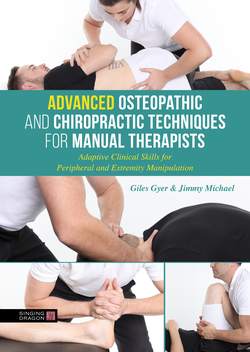Читать книгу Advanced Osteopathic and Chiropractic Techniques for Manual Therapists - Giles Gyer - Страница 6
На сайте Литреса книга снята с продажи.
Discussion Relationship between biomechanical changes and neurophysiological responses of a given spinal manipulation
ОглавлениеThe clinical effects of spinal manipulation are thought to be mediated by biomechanical and/or neurophysiological mechanisms. However, the exact mechanism(s) through which spinal manipulation exerts pain-modulatory effects, influences tissue repair and healing, and restores functional ability remains a mystery. Over the past decades, numerous hypotheses have been offered to explain these mechanisms, but evidence to support these theories is still limited. The evidence to date suggests that the effects of spinal manipulation are beyond biomechanical changes; in fact, a cascade of neurophysiological mechanisms may be initiated (Schmid et al. 2008). Biomechanical changes that occur due to spinal manipulation are thought to be produced by vertebral movement. The high-velocity, low-amplitude (HVLA) thrust introduced at the vertebral level during spinal manipulation mobilises the vertebrae on one another and is presumed to alter segmental biomechanics. In addition, the produced vertebral movement is known to be complex, as several adjacent vertebral levels are mobilised simultaneously (Maigne and Vautravers 2003; Potter et al. 2005).
There are four main theories of biomechanical changes elicited by spinal manipulation. These are (1) release of entrapped synovial folds or meniscoids; (2) restoration of buckled motion segments; (3) reduction of articular or periarticular adhesions; and (4) normalisation of ‘hypertonic’ muscle by reflexogenic effect (Evans and Breen 2006). However, the relevance of these theories on clinical outcomes remains uncertain. This is due to the fact that although a number of studies have quantified motion with spinal manipulation, biomechanical effects were found to be transient in nature (Colloca, Keller and Gunzburg 2004; Colloca et al. 2006; Coppieters and Butler 2008; Funabashi et al. 2016), and no plausible evidence has yet been found in support of a lasting positional change (Bialosky, George and Bishop 2008a). So far, only the muscular reflexogenic theory has some plausible evidence in support of its mechanical explanation (Clark et al. 2011; Colloca and Keller 2001; Currie et al. 2016); nevertheless, the clinical assertion that hypertonic muscles are influenced by an increased stretch reflex gain is not yet proven (Zedka et al. 1999). Furthermore, a common explanation widely propagated for the success of spinal manipulation is that it corrects changes in biomechanical dynamics, specifically position and movement faults, detected on examination. However, a majority of the current literature does not validate this explanation. This is because palpation has not been found to be a reliable method to identify areas requiring spinal manipulation (Seffinger et al. 2004; Walker et al. 2015), and the thrust applied during a therapy cannot be specific to an intended location (Frantzis et al. 2015) and varies between therapists (Cambridge et al. 2012).
The success of spinal manipulation in treating musculoskeletal disorders despite theoretical inconsistencies in its supposed biomechanical mechanisms indicates the possibility of concurrent additional mechanisms. Biomechanical changes evoked as a result of spinal manipulation may induce neurophysiological responses by influencing the inflow of sensory input to the central nervous system (Pickar 2002). Moreover, the mechanical force applied during spinal manipulation could either stimulate or silence mechanosensitive and nociceptive afferent fibres in paraspinal tissues, including skin, muscles, disc or discs, facet, tendons and ligaments (Currie et al. 2016; Randoll et al. 2017). These inputs have been thought to stimulate pain-processing mechanisms and other physiological systems connected to the nervous system (Bialosky et al. 2008a, 2009; Clark et al. 2011; Maigne and Vautravers 2003; Pickar 2002). In support of this hypothesis, Pickar and Bolton (2012) developed the notion that neural responses arising from the nervous system due to mechanical stimulus might be because of alterations in peripheral sensory input from paraspinal tissues.
Taken together, it can be said that changes in spinal biomechanics trigger the chain of neurophysiological responses responsible for the therapeutic outcomes associated with spinal manipulation, and there is a potential for combined biomechanical and neurophysiological effects following spinal manipulation. However, the possible interaction of these effects has frequently been overlooked in the current literature. The possibility of a combined effect is important to consider as biomechanical characteristics of a given spinal manipulation are shown to have a unique dose–response relationship with biomechanical, neuromuscular and neurophysiological responses (Cambridge et al. 2012; Downie, Vemulpad and Bull 2010; Nougarou et al. 2016). For example, paraspinal electromyographic (EMG) responses have an apparent dependence on the force/time characteristics of the mechanical thrust applied during spinal manipulation (Colloca et al. 2006). Therefore, future clinical studies should be conducted to investigate the relationship between variations in mechanical parameters (e.g., preload, peak force and thrust) and physiological responses and the relevance of varying parameters with biological and therapeutic outcomes.
